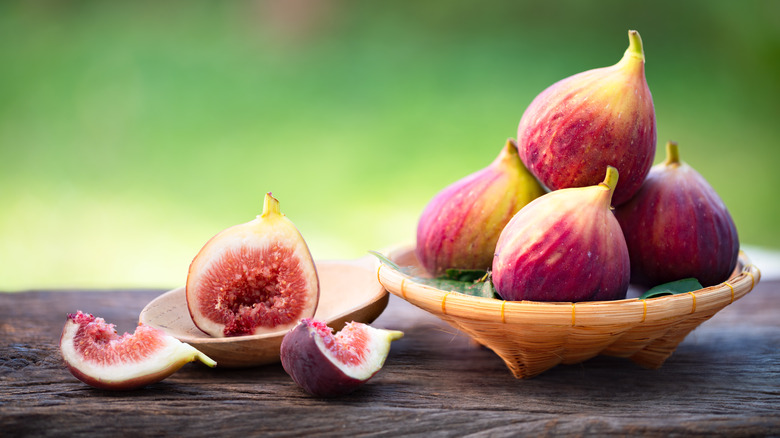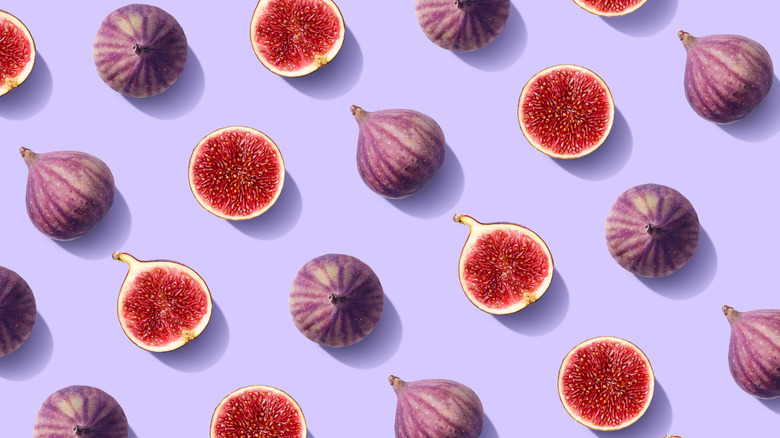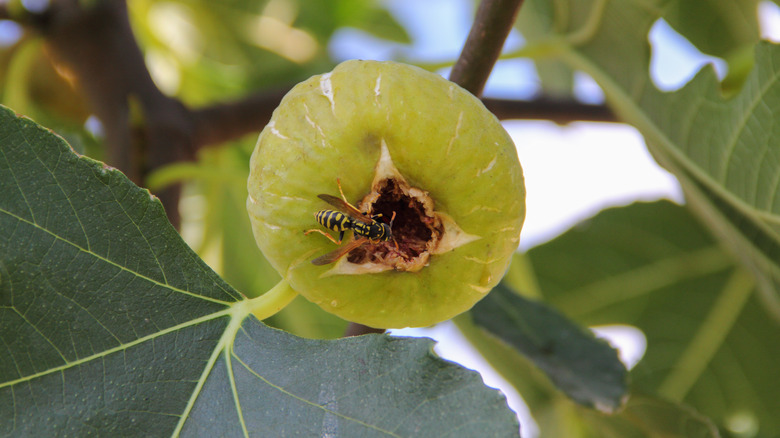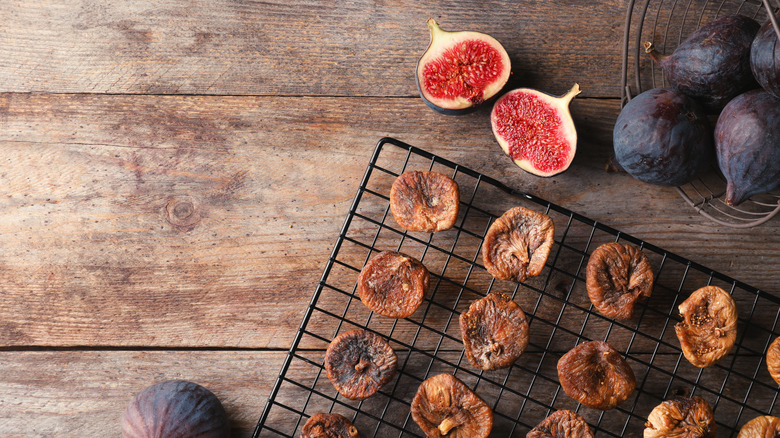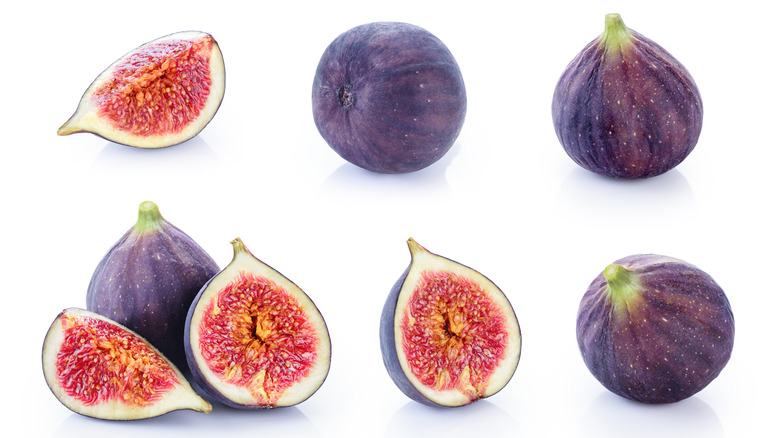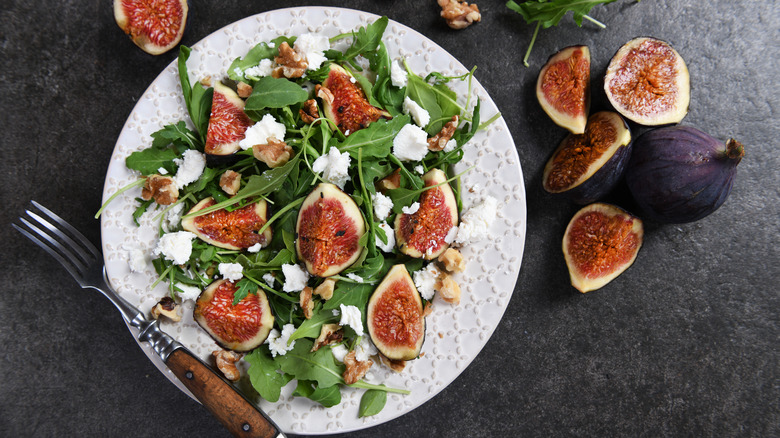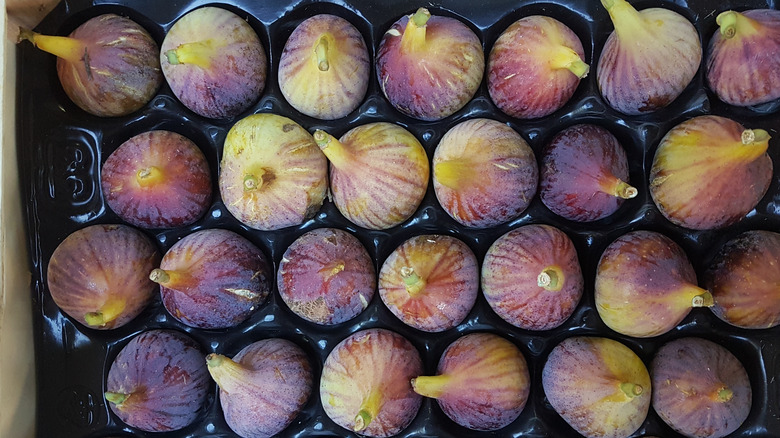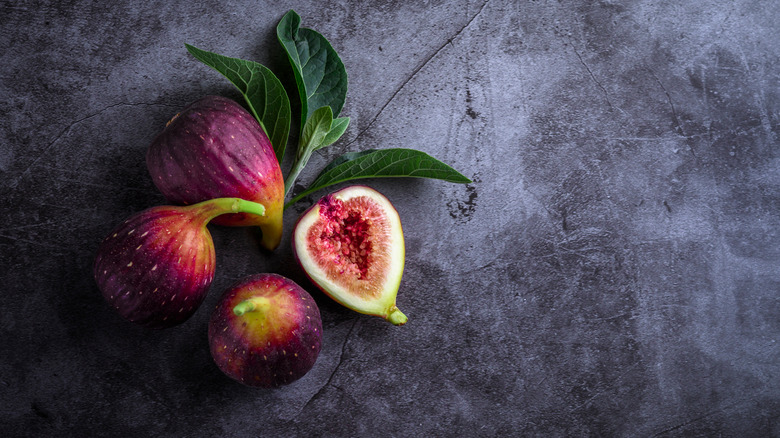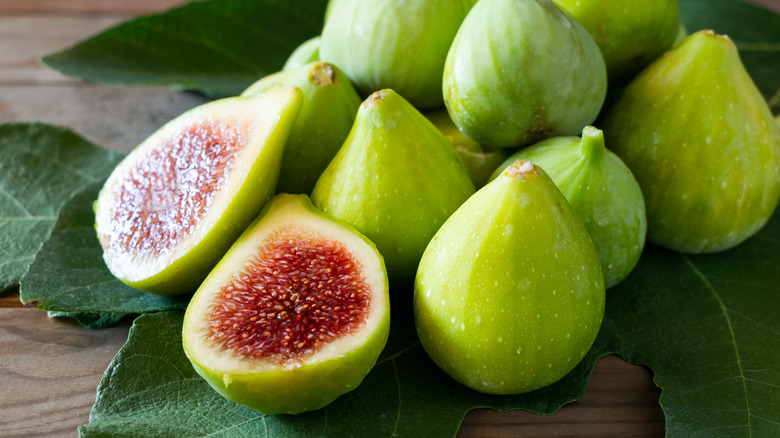What Are Figs And Are They Nutritious?
Fig leaves were the clothing of choice for Adam and Eve in the Garden of Eden, and their sacred nature has been preserved over many millennia up through modern day. The fig tree (Ficus carica) is also believed to be one of the first fruit trees ever cultivated, as evidenced by the fossilized remains found in Jordan that predate even wheat and barley (via Time for Grub). From the Greeks to the Romans and Egyptians, the common fig has a long history in both mythology and daily life. Revered by the Greek Olympians (and worn as medals no less), important in religious ceremonies, and perceived as symbols of prosperity, figs have long been more than just an edible plant.
Yet, their impressive history aside, figs are incredibly nourishing sources of a range of vitamins, minerals, and nutrients. These healthy properties are all encapsulated within a sweet plump and luscious fruit that easily satisfies even the sweetest tooth. The Greeks realized this quickly, and Britannica reports that the ancient civilization even imposed exportation laws to prevent losing the precious fruit to other countries. Whether you eat them fresh off the tree, dried, or cooked into a unique recipe, the options for devouring these fruit jewels are countless — and there's plenty to get to know about figs to admire them even more.
What are figs?
Although figs are considered a fruit in culinary terms, BBC explains that they are actually inverted flowers that bloom within an encasing called syconia. While there are variations in development depending on the type of fig, Britannica clarifies that the majority must be pollinated by fig wasps via an opening at their base. According to Taste, there are hundreds of species of figs and each one has its own unique pollinator wasp.
The edible fruit, which varies from the size of a marble to a pear, has a characteristic teardrop shape — and the skin of the fruit can range from light green to dark purple in color depending on the variety, while the flesh inside can be shades of pale pink to darker plum. Britannica indicates that figs are members of the mulberry family Moraceae, which also includes jackfruit, breadfruit, and rubber trees. Like them, figs grow on bushes or small trees that can be anywhere from 3-39 feet tall.
From Biblical and mythical tales to modern-day commercial production, the fig has really come far in its time on Earth. According to Britannica, figs are indigenous to the Middle East and are primarily found in Mediterranean climates. Although they are often considered to be a delicacy, the source remarks that they are so abundant in the Mediterranean, they are consequently often referred to as the poor man's food. In the 1500s, figs were spread to America by Spanish missionaries that later planted them in Mexico and California (via Food Republic). They are now grown commercially in California and as well as throughout the Mediterranean region.
Why are figs not considered vegan?
To avoid confusion, most people refer to figs as a fruit, however they are indeed flowers. As mentioned, the development of a fig relies on the action of wasp pollination. World's Healthiest Foods explains that the wasp pollinates the flower via a small opening at the base of the fig called the ostiole. However, Taste points out that the gap is generally narrow and wasps usually lose their wings and antennae in the process, eventually dying inside the inverted mass. The source describes this process as enzymatic digestion by the fig.
While the actual physical components of the wasp essentially become the fruit, Vegan Life affirms that, except in the case of commercial figs grown without wasp pollination, there's no denying that a dead wasp is contained inside every fig. While the source agrees that the specific limits of veganism are decided by individuals, they do point out that death by pollination isn't necessarily worse than animal deaths associated with the harvest of crops such as wheat.
Therefore, while a fig is indeed plant-based, the inherent means by which it grows may make it off-limits for most vegans. But, as with many lifestyles choices, these are personal in nature and someone may follow a vegan lifestyle and still decide to eat figs.
Fresh figs vs. dried figs
Fresh figs are extremely perishable, and as a result of their fragility, The Los Angeles Times reports that around 90% are dried shortly after harvest to preserve them. To do so, figs are either dried naturally in the sun or through the use of machines. Due to the loss of water, Healthline indicates that the sugar content in dried figs becomes highly concentrated as a result. Therefore, a single dried fig compared to a fresh one will contain more sugar, more carbohydrates, and more calories. Since dried figs are denser, they will also contain a greater amount of fiber.
It's also best to check the ingredients on packages of dried figs since some manufacturers add sugars or syrups that may be unwanted. The vitamin and mineral content is similar between dried and fresh figs, though when dried, figs lose most of their vitamin A content. On the other hand, dried figs are praised for their higher antioxidant activity, as discovered by a 2005 study in the Journal of the American College of Nutrition.
As far as taste goes, the primary difference between fresh and dried figs is the texture. Fresh figs are plump and jammy whereas dried figs are chewy since the juice content has dried up. For a similar distinction, think of the difference between a raisin and a grape.
What do figs taste like?
There are dozens of commercially available varieties of figs, and each will have their own unique characteristics. Unripe figs can be dry and firm, lacking flavor and sugar (hopefully you don't land on one of these the first time you try it!). On the other end of the spectrum, a perfectly ripe fig will be soft and tender, with silky flesh that can border on jammy. Some varieties have more seeds, which provide additional crunch.
Figs are undeniably sweet with flavors of caramel, honey, and butterscotch, paired with fresh ripe berries. The ideal fig is most certainly luscious and decadent, making the perfect dessert eaten fresh in its natural state. Dried figs have similar rich flavors and hints of caramel with a chewy texture.
Although you'd be satisfied simply eating raw figs, they make a delicious addition to recipes when cooked, too. The sugars caramelize, creating flavors that can only be described as sumptuous.
How to cook with figs
Figs can be enjoyed in all forms — fresh, raw, cooked, or dried. Whether you peel figs is up to personal preference, though some varieties have particularly thick skin — but if you do eat the skin, at the very least, cut off the stem, which is slightly stiff with no redeeming flavors.
Fresh figs can be halved, quartered, or sliced into rounds. Their nectar-like sweetness pairs well in salads with bitter greens, some kind of cheese, and a balsamic vinaigrette. Add figs to a cheese and charcuterie board for a perfect match up or top on a pizza for a pleasant contrast that thrives amongst the salty, creamy, and sweet flavors.
Greatist suggests serving them with plain yogurt, crème fraîche, vanilla ice cream, or porridge for some natural sweetness. For extra caramelized flavors, the site also recommends broiling them with some butter for a syrupy treat. Another idea is to stuff figs with cheese or wrap them with bacon or prosciutto for a sweet and salty combination.
Since fresh figs are highly perishable, another great idea is to use them to make jam, with the finished product able to keep in the fridge for up to 10 days. Once ready, spread the jam on toast with nut butter for a twist on the classic peanut butter and jelly pairing. As well, you can use fresh and dried figs in baked goods such as cookies, tarts, or your own take on Fig Newtons. For a simple yet impressive dessert, dip fresh or dried figs into melted dark chocolate and allow it to harden in the fridge.
Where to buy figs
Fresh figs are seasonal and can generally be found from late spring to late fall. If you need a fix any other time of the year, dried figs are the way to go. When available, supermarkets will stock fresh figs in the produce aisle, whereas the dried kind are more commonly found with other dried fruits and nuts. Natural food stores will often stock fresh figs seasonally and dried figs year-round. Finally, if you live somewhere with a warmer Mediterranean climate, you may be lucky and manage to find them at a local farmers' market or even grow them yourself.
When choosing figs, go for those that are slightly soft to the touch, and avoid any stiff figs since they won't be able to ripen off the tree. Plum, ripe figs will be tender but shouldn't be mushy or have excess juice seeping out. BBC Good Food advises following your nose and opting for fragrant figs with no discernible sour aromas. According to the source, you should only wash your figs right before eating them, which should be within three days. For extremely ripe figs, store them in the fridge, otherwise they can be kept in a basket on the counter as long as there is sufficient air circulation to avoid mold.
If you come upon an abundance of figs, you can also freeze them for a longer shelf life.
Nutritional information about figs
The ancient Greeks believed that figs were worth consuming and they were right. The fresh fruits are brimming with vitamins, minerals, and fiber. In terms of vitamins, Greatist reports that figs are a great source of A, B, C, and K. Though, Healthline warns that people taking blood thinners should watch their consumption due to possible interactions with vitamin K.
A multitude of minerals are present in figs as well, including high levels of calcium, potassium, phosphorus, and iron (via Britannica). As well, Greatist indicates that magnesium, copper, and zinc are plentiful. These nutrients may assist in brain, muscle, bone, heart, and nerve function. Regular consumption can also have a positive effect on blood pressure according to BBC Good Food.
For a fruit packed with so many nutrients and a delicious sweet flavor, Healthline remarks that figs are relatively low in calories and contain minimal quantities of protein or fat. The majority of calories come from natural sugar carbohydrates, which are more concentrated in dried figs.
Another significant quality of figs is their high fiber content. A 2019 study in Explore demonstrated that eating dried figs daily could possibly reduce IBS symptoms related to constipation. Indeed, the fiber in figs is prebiotic and promotes healthy gut bacteria (via Healthline). However, too much fiber can cause a laxative effect and bloating, so stick with moderation when it comes to eating figs.
Fig allergies do exist, usually affecting people that are also allergic to birch pollen, fruit from the mulberry family, or rubber latex, so take caution if any of those pertain to you.
Other varieties of figs
According to Trees.com, there are hundreds of species of fig trees, mostly native to warmer regions. Britannica notes that the exact number is hard to pinpoint since many fig trees are given new names wherever they grow. However, when it comes to commercial figs, the number dwindles significantly.
Food Republic remarks that half a dozen types are prevalent, including the Kadota, Black Mission, Adriatic, Calimyrna, Sierra, Brown Turkey, and Desert King figs, among others. The source explains that different varieties are distinguished by their skin and flesh color, their size, and some nuanced flavors. For example, Black Mission figs are small and especially sweet, with pink flesh and dark plum-colored skin.
Meanwhile, Food Republic describes the Kadota as the most common green-skinned fig. It is thought to be 1000s of years old, and Greatist recommends using it for jams and preserves. Another green-skinned variety is the large, round Sierra fig which was bred at the start of the millennium (via Food Republic). Although most figs do best in warm climates, Planet Fig indicates that the green-skinned King Desert fig is cold-tolerant and grows well in the Pacific Northwest.
As for the pear-shaped Brown Turkey fig, Greatist notes it is less sweet, and ideal for adding to salads. Calimyrna figs are commonly dried, and have a particular butterscotch caramel flavor, according to Food Republic. Adriatic figs are the best when fresh and are often baked into fig bars.
Local availability and imports dictate access and price, but it's good to know there's an abundance to choose from on any given day.
